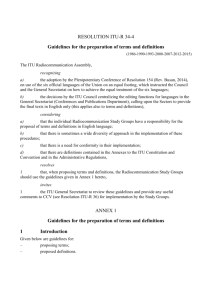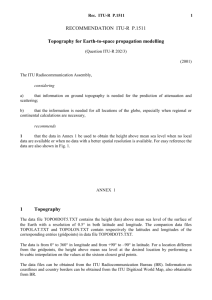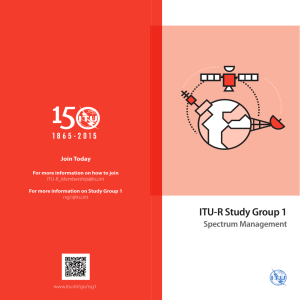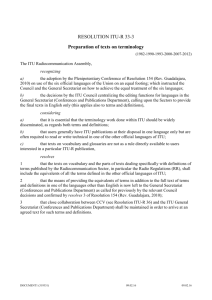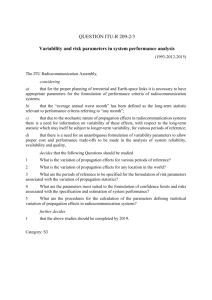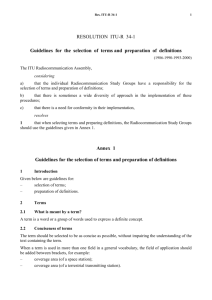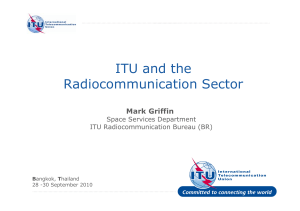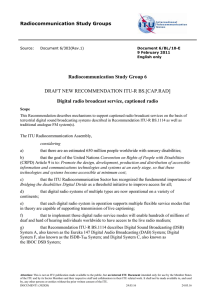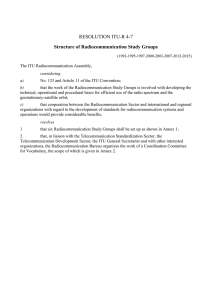itu-r radiocommunication study group work
advertisement
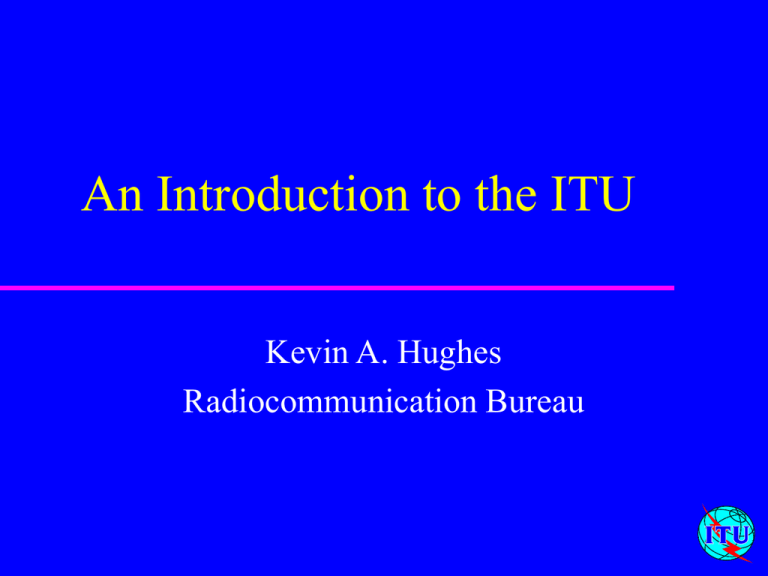
An Introduction to the ITU Kevin A. Hughes Radiocommunication Bureau 1 The ITU (International Telecommunication Union) • • • Founded in 1865 “… is an international organisation within which governments and the private sector coordinate global telecommunication networks and services” Foundation for today’s radiocommunications services 2 Roles of ITU • Regulation – spectrum management and coordination » Radio Regulations • Standardisation – ITU Recommendations » seamless interworking of systems on a global basis » technical characteristics/specifications, operational procedures, “best” practices • Development – assistance to developing countries » improving telecoms infrastructure in the developing world » catalyst for forging development partnerships » increasing awareness of today’s technologies 3 ITU Membership • ITU founded on principle of cooperation between governments and the private sector • Membership encompasses: – – – – – – – telecoms policy makers regulators network operators equipment manufacturers hardware and software developers regional standards-making organizations financial institutions • ITU shaped by the industry it serves 4 ITU MEMBERSHIP • Member States (governments): 189 • Sector Members: 660 – – – – – – Recognised Operating Agencies Scientific or Industrial Organisations Other entities dealing with telecom matters Regional or other International Organisations Region Telecommunication Organisations Intergovernmental Orgs. operating sat. systems • Associates 5 ITU Governing Bodies • Plenipotentiary Conference – Constitution and Convention of ITU • Council – policies and strategy – coordination role • World Conferences – to negotiate agreements serving as basis for operation of global telecoms services – Radiocommunication Conferences, e.g. WRC-2000 6 World Radiocommunication Conferences (WRC) • Changes to the Radio Regulations – accommodate new systems and services – increased demands for spectrum • Table of frequency allocations (Article 5) – 9 kHz – 275 GHz – footnotes • Frequency plans – e.g. broadcasting satellite plan at ~ 12 GHz – assignment plans – allotment plans 7 ITU ORGANISATION • Radiocommunication Sector (ITU-R) (secretariat BR) • Telecommunication Standardisation Sector (ITU-T) (secretariat TSB) • Telecommunication Development Sector (ITU-D) (secretariat BDT) • General Secretariat 8 RADIOCOMMUNICATION SECTOR (ITU-R) Aim: “.. to ensure rational, equitable, efficient and economical use of the radio-frequency spectrum and satellite orbits” “.. to carry out studies and adopt Recommendations on radiocommunication matters” 9 ITU-R objective Objective achieved through (inter alia): • • World (and Regional) Radiocommunication Conferences Approval of Recommendations Technical studies are required which are conducted in Study Groups 10 ITU-R Study Groups • Groups of experts from ITU membership • Draft technical bases for WRCs (and RRCs) • Draft Recommendations – technical characteristics – operational procedures • Compile Handbooks • Radiocommunication Assembly 11 Study Groups • • • • • • • SG 1: SG 3: SG 4: SG 6: SG 7: SG 8: SG 9: Spectrum management Radiowave propagation Fixed-satellite service Broadcasting service Science services Mobile services Fixed service 12 ITU-R Study Groups • Currently 7 Study Groups • Subordinate groups – – – – Working Party Task Group Rapporteur Group Joint ……. • Coordination Committee for Vocabulary • Special Committee (regulatory/procedural) • CPM - Conference Preparatory Meeting 13 Scope of Study Group 1 (Spectrum management) • Principles and techniques for – – – – spectrum management sharing criteria and methods spectrum monitoring long-term strategies for spectrum utilization • Inter-service sharing and compatibility 14 Scope of Study Group 3 (Radiowave propagation) Propagation of radiowaves in ionized and non-ionized media and the characteristics of radio noise, for the purpose of improving radiocommunication systems 15 Scope of Study Group 4 (Fixed-satellite service) Systems and networks for the FSS and inter-satellite links (in the FSS), including associated tracking, telemetry and telecommand functions 16 Scope of Study Group 6 (Broadcasting service) Radiocommunication broadcasting (terrestrial and satellite) of vision, sound, multimedia and data services primarily intended for delivery to the general public 17 Scope of Study Group 7 (Science services) • Systems for space operation, space research, Earth exploration and meteorology • Radio astronomy • Standard frequency and time signals 18 SG 7 - some key areas of study - • Allocations for space science services – space operations and space research services – precipitation radars (~ 35 GHz) – Earth exploration satellite service (420-470 MHz) • Radio astronomy – protection criteria 19 Scope of Study Group 8 (Mobile services) Systems and networks for the mobile, radiodetermination and amateur services, including related satellite services 20 Scope of Study Group 9 (Fixed service) Systems and networks of the fixed service operating via terrestrial stations 21 Joint Studies • Joint Task Group (JTG) 4-7-8-9 5 GHz band allocations – WRC-03 AI 1.5 – Resolution 736 (WRC-2000) • JTG 4-7-8 Sharing in band 13.75-14 GHz – WRC-03 AI 1.24 – Resolution 733 (WRC-2000) 22 Study Group Products • Technical bases for WRC – Conference Preparatory Meeting (CPM) – CPM report to WRC • Draft ITU-R Recommendations • Handbooks 23 CPM Report to WRC-03 1. Radionavigation, radnav-sat and radiolocation services 2. Mobile, mob-satellite and space science services 3. Fixed-satellite and broadcast-sat services 4. Fixed and fixed-sat services and HAPS 5. Maritime-mobile, amateur and am-sat, and b’cast services at MF and HF 6. Other matters 7. Future work programme 24 ITU-R Recommendations • > 900 Recommendations in 16 series • “Standards” in areas of spectrum management and radio technology • Result of consensus from meetings of world-wide experts • Some referred to in RR • Used by spectrum planners and system designers 25 ITU-R Handbooks • • • • • Over 30 published Tutorial in nature Emphasis on use by developing countries Liaison with ITU-D (and ITU-T) Continuing Handbook programme in ITU-R 26 Concluding remarks • The Study Groups represent a major aspect of ITU-R activities • Technical forum for discussion amongst experts • Technical bases for Radio Conferences • Recommendations and Handbooks 27
